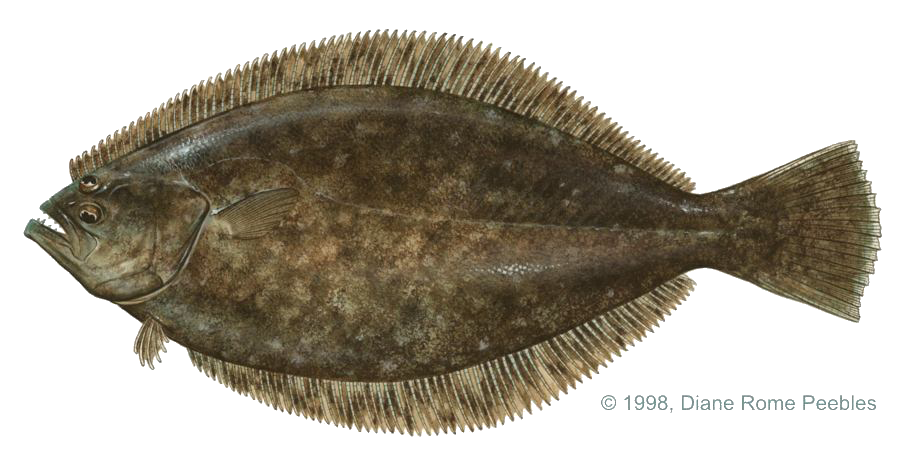Game Fish Identification Reference Guides
Flounder, summer
(Paralichthys dentatus)
(Paralichthys dentatus)

(Linnaeus, 1766); BOTHIDAE FAMILY; also called fluke
Occurs in the western Atlantic from Maine to South Carolina and possibly to northeast Florida. It may be found in water as shallow as 6 in (15 cm) during the summer, though the largest specimens are found in depths of 8 to 10 fathoms. In the winter the large fish move offshore into depths of 25 to 80 fathoms.
The summer flounder is a left eyed flatfish. The eyed side always blends in perfectly with the sea bed. There is usually a scattering of 10 to 14 eye like spots on the body. As in other flatfish, the blind side is white and relatively featureless. The teeth are well developed on both sides of the jaws. The dorsal fin has 85 94 rays; the anal fin has 60 63 rays. There are only 5 or 6 gill rakers on the upper limb of the first arch and 11 21 on the lower limb.
Adults are largely piscivorous and highly predatory, feeding actively in midwater as well as on the bottom. They are often seen chasing bait fish at the surface. It is a rapid swimmer and a good light tackle game fish that provides lively action. It prefers sandy or muddy bottoms and is common in the summer months in bays, harbors, estuaries, canals, creeks, and along shorelines as well as in the vicinity of piers and bridges.
Drift fishing is the most common fishing method and probably the most effective, since drifting covers more bottom and keeps the bait or lure in motion. Many are also taken by chumming while fishing at anchor, by trolling, or by casting from shore or pier. Effective baits include strips cut from shark, fluke menhaden, herring, porgy, young bluefish, or sea robin; or a piece of blue crab. Effective lures include a small spoon, spinner, or feather. Some time must be allowed between the moment the flounder picks up the bait and the strike, or the bail may simply be yanked away. Inshore fishing is best on a running tide, and the largest fish are caught late in the season.
It is an excellent food fish; the flesh is white firm, and succulent. It is by far the most important flatfish of the Atlantic states
Occurs in the western Atlantic from Maine to South Carolina and possibly to northeast Florida. It may be found in water as shallow as 6 in (15 cm) during the summer, though the largest specimens are found in depths of 8 to 10 fathoms. In the winter the large fish move offshore into depths of 25 to 80 fathoms.
The summer flounder is a left eyed flatfish. The eyed side always blends in perfectly with the sea bed. There is usually a scattering of 10 to 14 eye like spots on the body. As in other flatfish, the blind side is white and relatively featureless. The teeth are well developed on both sides of the jaws. The dorsal fin has 85 94 rays; the anal fin has 60 63 rays. There are only 5 or 6 gill rakers on the upper limb of the first arch and 11 21 on the lower limb.
Adults are largely piscivorous and highly predatory, feeding actively in midwater as well as on the bottom. They are often seen chasing bait fish at the surface. It is a rapid swimmer and a good light tackle game fish that provides lively action. It prefers sandy or muddy bottoms and is common in the summer months in bays, harbors, estuaries, canals, creeks, and along shorelines as well as in the vicinity of piers and bridges.
Drift fishing is the most common fishing method and probably the most effective, since drifting covers more bottom and keeps the bait or lure in motion. Many are also taken by chumming while fishing at anchor, by trolling, or by casting from shore or pier. Effective baits include strips cut from shark, fluke menhaden, herring, porgy, young bluefish, or sea robin; or a piece of blue crab. Effective lures include a small spoon, spinner, or feather. Some time must be allowed between the moment the flounder picks up the bait and the strike, or the bail may simply be yanked away. Inshore fishing is best on a running tide, and the largest fish are caught late in the season.
It is an excellent food fish; the flesh is white firm, and succulent. It is by far the most important flatfish of the Atlantic states













